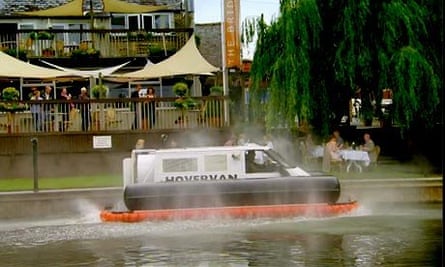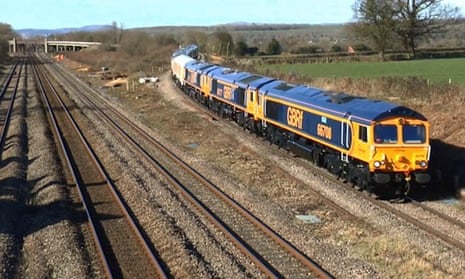‘It was not captioned as live on-screen to viewers, but in the excitement of a live broadcast, it was mistakenly suggested that it was a live spot.” A BBC spokesperson there, reacting to the startling revelation that footage of a Class 66 train on Monday night’s episode of Trainspotting Live was not, in fact, live. Even though host Peter Snow had excitedly proclaimed, “We’ve just seen one going past … There we are, Class 66” and the show was called Trainspotting Live. In reality, the footage was five months old, and had been included to inject a drab episode with the kind of pizazz only a Class 66 diesel locomotive can provide.
It would be comforting to say that this was an isolated incident – that, though trust in Snow, one of TV’s sturdiest oaks, is shaken, such chicanery in documentaries is unheard of. But no: skullduggery in supposedly “factual” television is shockingly commonplace. Though perhaps, in some cases, the public should not be quite so easily hoodwinked.
Top Gear – (hover)crafty sods

The original trio of the loud one, the nerdy one and the other one were tasked with making a hovercraft out of a Transit van. So far, so Top Gear. But when they took their creation (read: the creation of a large team of uncredited engineers) on the Avon for a spin, hilarious japes ensued, including unwitting patrons of a riverside restaurant getting drenched. Only they weren’t – because all the patrons were in fact actors. People were furious. Brilliantly, the BBC issued a statement saying it assumed viewers were “intelligent enough not to have been taken in”. Yeah, you idiots.
Megalodon – The Monster Shark That Lives (only it doesn’t)
To kick off Discovery’s Shark Week in 2013, it aired a documentary entitled Megalodon – The Monster Shark That Lives, about a long-extinct species of supershark that was a whopping 60ft long, with teeth “the size of butchers’ knives” and a penchant for eating whales. Scary stuff – particularly since the documentary suggested they still stalked the ocean deep. In the closing credits, an odd disclaimer flashed across the screen: “None of the institutions or agencies that appear in the film are affiliated with it in any way, nor have approved its contents”. Which, as some viewers noted, is lawyerspeak for “we might have made this all up”. And so it was: the show’s marine biologists were actors, the footage of an aqua-beast taking down a boat was a sham, and “evidence” that a whale had lost a dust-up with a megalodon and had its tail bitten off was as counterfeit as a Romex watch. The public was duped. As, unforgivably, was Star Trek’s Wil Wheaton. Though we can all probably swim easier knowing there isn’t a shark the size of a Class 66 locomotive skulking in the shallows.
Frozen Planet – polar bear-gate

In 2011, the BBC came a cropper after it emerged that adorable footage of newborn polar bear cubs snuffling in their den was filmed in a Dutch animal reserve, as opposed to the howling Arctic tundra that the show’s editing would lead you to believe. In the BBC’s defence, it had made the footage available on its website, along with information as to its provenance, prior to broadcast, and Attenborough narrating “Now, we cross over to a manmade bear-hole in Holland” might have diluted the magic somewhat. So why was it done David? WHY? “If you had tried to put a camera in the wild in a polar bear den, she would either have killed the cub or she would have killed the cameraman.” Oh. Ok then. Fair enough.
The Connection – a hard-hitting drug sham
In 1998, TV production company Carlton was fined a huge, then-record fine of £2m for airing a hard-hitting documentary about the UK drug trade. The Connection purported to portray drug traffickers in the UK and a Colombian drug cartel. Only the Guardian revealed that the cartel “insider” interviewed was actually a researcher on the show, dealers were played by actors, and the heroin seen on screen, according to the Independent Television Commission, was in fact “sweets”. Quite which type of sweet remains unclear.
Most Haunted – ghouling the public
It’s a show about finding ghosts, and yet every ghost “channelled” mysteriously shares the same thick scouse accent as its medium, Derek Acorah. No one is claiming 100% factual accuracy here. But viewers assumed that, when Yvette Fielding, Acorah and their ghost-bothering gaggle heard a bump in the night, it was genuine – even if it was then ascribed paranormal origins by both the show’s presenters and its viewership of gullible idiots. Then, in 2005, the Mirror exposed a series of unsavoury incidents: soundmen being pushed to mimic a “poltergeist” attack. Fielding making ghostly noises with her face. Acorah “channeling” ghosts of people that – damningly – didn’t actually exist. It was one of the show’s stars, Dr Ciaran O’Keefe, who exposed the culture of gubbins, throwing trust in preternatural expertise back by decades. Because, if you can’t trust a man who thinks Michael Jackson was a scouser, who can you trust?

Comments (…)
Sign in or create your Guardian account to join the discussion